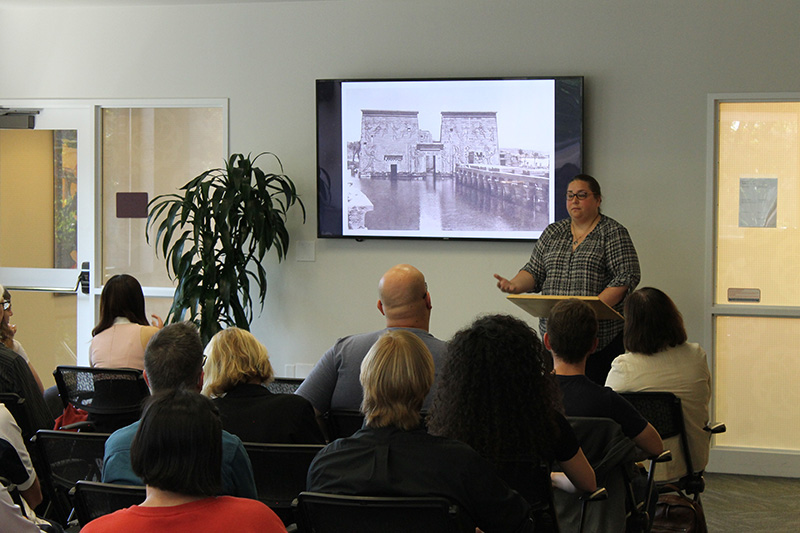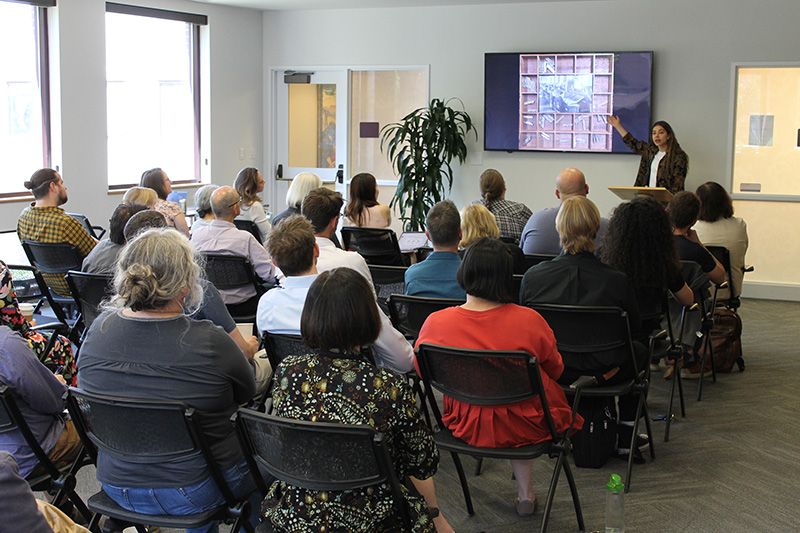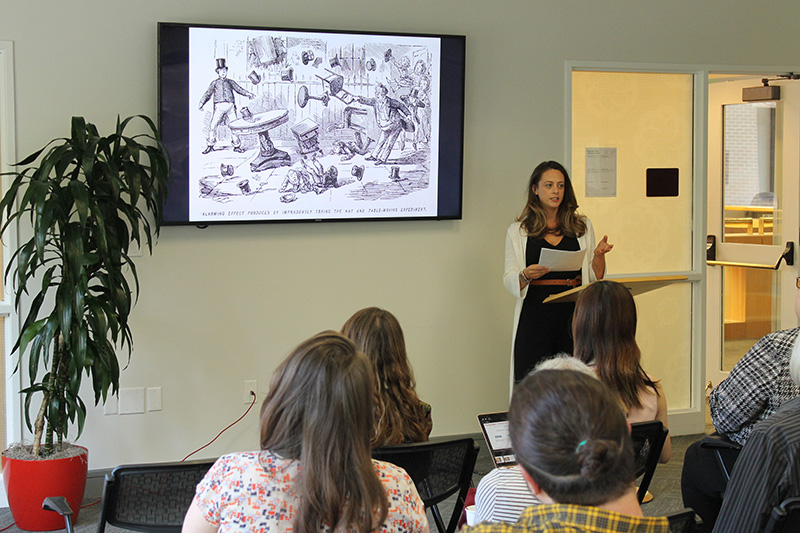Lightning Talks Showcase Faculty and Post-Doctoral Fellow Research
Robert Carson, Associate Director, Tanner Humanities Center, September 18, 2024
An initiative in the College of Humanities in its second year, the Lightning Talks series invites early-career faculty and postdoctoral fellows to share their research in a quick, 15-minute presentation organized around a single image or artifact of their choosing. According to Isabel Moreira, Associate Dean for Research, “It has been so exciting to hear the research ideas that our newest faculty and postdocs are bringing to the college. So often, only the hiring departments know who the new faculty are and what they are doing. The Lightning Talks series allows everyone in the college to find out what everyone else is doing in a fun, informal, and meaningful way. It would be wonderful if future research collaborations came out of connections made as soon as faculty join the college, but it is also just a wonderful opportunity to have good conversations.”
Jordan Johansen, World Languages and Cultures: “Approaching a Flooded Border”
 The Temple of Isis on the island of Philae in the Nile River is a palimpsest of civilizational
identity. In her talk, Professor Johansen explored how the temple was literally made,
marked, and almost destroyed by the forces of history. It was built under the rule
of the Ptolemaic pharaohs (including Cleopatra’s father) to consolidate the ecological,
political, and theological border between Egypt and Nubia. This border would go on
to influence subsequent thought about the distinctions between Egyptian and other
African cultures.
The Temple of Isis on the island of Philae in the Nile River is a palimpsest of civilizational
identity. In her talk, Professor Johansen explored how the temple was literally made,
marked, and almost destroyed by the forces of history. It was built under the rule
of the Ptolemaic pharaohs (including Cleopatra’s father) to consolidate the ecological,
political, and theological border between Egypt and Nubia. This border would go on
to influence subsequent thought about the distinctions between Egyptian and other
African cultures.
Fast forward to 1905, nearly two millennia after the last pharaoh, and the temple was submerged as shown in the photograph presented by Professor Johansen. However, the waters were not from the Nile’s natural flooding, but from the newly constructed Aswan Dam. The dam destroyed ancient sites and displaced modern communities, raising protests from archeologists.
Debates about the first Aswan Dam also inspired African American intellectuals like Pauline Hopkins, whose novel, Of One Blood: Or, The Hidden Self, was written during its construction. Hopkins was part of a movement to connect modern African-American identity to ancient African civilization as a source of cultural and social advancement.
In the discussion after her talk, Johansen noted Pauline Hopkins’s prescience about new recoveries of African history, including the significance of the Temple of Isis.
Daniela Samur, History: “Working with Prints”
 States and governments depend on paper: bills, letterheads, legal codes, forms, and
the like. It is hard to imagine a new state forming without considerable investments
in paper and printing. However, just as it can be easy to take paper and printing
for granted, it can be even easier to ignore the question of who makes printed material,
and under what circumstances.
States and governments depend on paper: bills, letterheads, legal codes, forms, and
the like. It is hard to imagine a new state forming without considerable investments
in paper and printing. However, just as it can be easy to take paper and printing
for granted, it can be even easier to ignore the question of who makes printed material,
and under what circumstances.
Drawing on her archival work, Professor Samur examined a case used for organizing metallic type, and a photograph from a school in Bogota, Colombia in the early 20th century, depicting children working in a printshop. While the photograph provides a glimpse into this labor, it also raises questions: Why were the children working, and under what conditions?
The printshop was part of a school run by the Catholic Church’s Salesian order in Colombia. The goal of such programs was to mold a segment of the working class that was obedient and compliant to both church and state. The children were unpaid and were expected to work in silence. The children’s labor was often a route to upward mobility, through subsequent apprenticeships.
Relative to other working-class youth, the children in this school received a better education designed to turn them into loyal, technically skilled workers for the emerging state. Under the supervision of priests and nuns, the children in this particular shop produced tax records and forms. In this way, the archival photograph examined by Professor Samur captures many dimensions of Colombia’s social and political history.
In the Q&A after her talk, Professor Samur discussed how the children’s work in the printshop was gendered: boys handled the type and machine presses, reinforcing their literacy and technical skills, while girls were tasked with folding and binding paper, without the same benefits. The program depicted in the photo also disrupted former labor arrangements: Before these schools, people typically learned printmaking directly in printshops; school-based unpaid child labor created a larger, more compliant technical workforce.
Sam Tett, English: “The Haunted House of Memory”

The sensation of déjà vu (French for “already seen”) is the well-known phenomenon of a new experience feeling strangely familiar. In contrast, jamais vu (French for “never seen”) occurs when one feels a sudden unfamiliarity in a familiar setting. This eerie or fearful sensation can make it difficult to interact normally with the environment. For example, a person might get into their car and freeze, unable to recognize the gas and brake pedals, as if they had lost all meaning.
Jamais vu emerged as a significant literary trope in the 19th century, although it was only formally named several decades later. Victorian authors vividly depicted this phenomenon, particularly in the 1850s, in a wave of “ghost stories” without actual ghosts. Instead, these tales portrayed inexplicable events, like household objects behaving strangely, as seen in Punch magazine’s parody cartoon. Crucially, these stories did not need supernatural elements to convey the eeriness of a home; the familiar setting itself became unsettling. Sam Tett’s research suggests that this strangeness reflected the disorientation brought on by industrial modernity, as homes and communities transformed beyond recognition at an accelerated pace. This literary craze grew in popularity, eventually becoming part of the broader Victorian Gothic tradition that gave rise to works like Bram Stoker’s Dracula.
During the Q&A, further exploration of jamais vu drew parallels to the experiences of returning soldiers, who often found their once-familiar homes alien. Tett also commented on the haunting nature of manufactured objects in particular: household objects were increasingly disconnected from traditional handicraft, becoming symbols of alienated labor.
Yang Yi, Communication: Dispelling Complexity

“When nothing goes right, go left.” This deceptively simple aphorism, according to Yang Yi, a postdoctoral fellow in Communication, can stand for an entire approach to public messaging.
In public communication campaigns which seek to impart complex knowledge, scholars and professionals need to be flexible and responsive when messaging efforts fail. It is crucial for scholars to recognize when messaging techniques don’t work and respond with new approaches, rather than doubling-down on an ineffective strategy.
In two different contexts—reacclimating students post-COVID, and training employees on the proper use of generative AI—Yi identifies the salience of a transparent communication model. In this model, complex information must be presented coherently and accessibly, the public must be invited to act and participate in some relevant way, and the messaging campaign must accommodate its audience’s preferences and limitations.
Sometimes, the information being conveyed is too complex. In these situations, it can be helpful to reframe the communication to recipients’ most immediate needs and concerns. Trustworthy experts or influencers can also help command the public’s attention to complex information.
In the Q&A, Yi and colleagues considered different factors, such as attention and ideology, that can limit a communication strategy’s performance with a certain public, as well as the public’s preferences for different media formats, such as short-form videos versus news articles.
